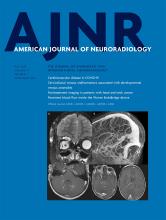Abstract
BACKGROUND AND PURPOSE: The Woven EndoBridge (WEB) device is an established technique for the treatment of intracranial aneurysms. Occasionally, persistent opacification inside the WEB lumen can be observed at follow-up (previously described as Bicêtre Occlusion Scale Score 1). We evaluated potential risk factors of this phenomenon, hypothesizing that initial deviation of the WEB device from the aneurysm axis, size of the aneurysmal neck surface, or inappropriate WEB sizing correlates with Bicêtre Occlusion Scale Score 1 findings.
MATERIALS AND METHODS: We systematically reviewed all patients treated with the WEB device between February 2014 and December 2018 in our neurointerventional center. Patients with midterm follow-up DSA available were considered for aneurysm evaluation applying the Bicêtre Occlusion Scale Score. WEB angle deviation from the aneurysm axis, neck widths, and WEB sizes were collected.
RESULTS: We included 65 patients with 67 intracranial aneurysms. Eleven of 67 (16.4%) intracranial aneurysms showed the Bicêtre Occlusion Scale Score 1 phenomenon at follow-up. Anterior-posterior projections of WEB axis deviation (angles measured in degrees) were significantly different between the Bicêtre Occlusion Scale Score 1 cohort (median ± interquartile range, 17 ± 17) and all other Bicêtre Occlusion Scale Scores (median ± interquartile range, 7 ± 11; P = .023), whereas in lateral projections, no significant difference was observed (median ± interquartile range, 10 ± 10 versus 8 ± 9; P = .169). Neck or aneurysm recurrence, but not the Bicêtre Occlusion Scale Score 1 phenomenon, occurred significantly more often in patients with inappropriate WEB sizing compared with appropriate WEB sizing (median ± interquartile range, 1 ± 1.3 versus 0 ± 0; P < .001/P = .664).
CONCLUSIONS: The Bicêtre Occlusion Scale Score 1 phenomenon is associated with an initial deviation of the WEB device from the aneurysm axis but does not correlate with aneurysmal neck surface measurements or WEB sizing.
ABBREVIATIONS:
- AcomA
- anterior communicating artery
- BOSS
- Bicêtre Occlusion Scale Score
- IA
- intracranial aneurysms
- IQR
- interquartile range
- WOS
- WEB Occlusion Scale
- WEB
- Woven EndoBridge
- © 2020 by American Journal of Neuroradiology












